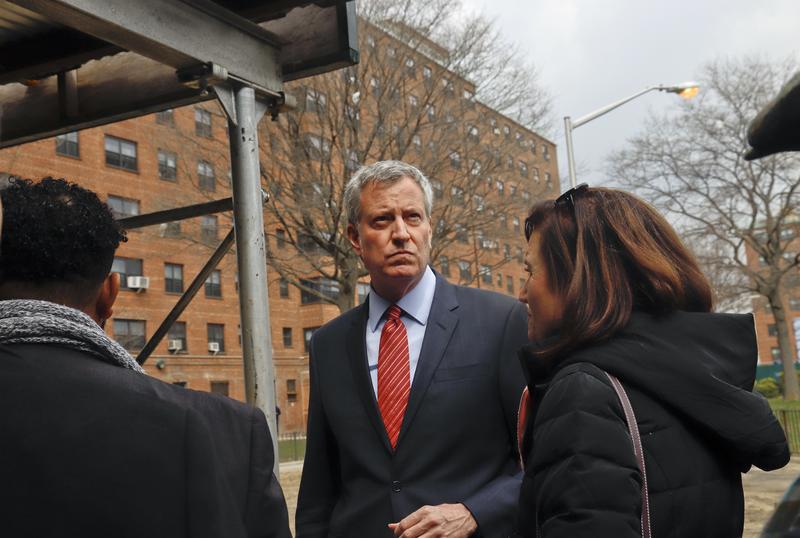
Nearly a year after the de Blasio administration announced a plan to turn around the New York City Housing Authority and identified ways to raise a majority of the $31.8 billion needed for capital repairs, one strategy isn’t working out as planned.
The city projected it could raise $2 billion over ten years through infill development, consisting largely of constructing new buildings in NYCHA complex land where there’s unused space, such as playgrounds, parking lots and open fields. Private developers would pay the housing authority upfront to lease the unused land and build mixed-income housing on it. The authority planned to use that money to repair 10,000 apartments.
Six development were slated for infill: Holmes Towers on the Upper East Side, Cooper Park in East Williamsburg, Wyckoff Gardens in Boerum Hill, LaGuardia Houses on the Lower East Side, Harborview Terrace in Hell’s Kitchen and Fulton Houses in Chelsea. Progress on all of them has been stalled or delayed, according to a recent analysis from the Citizens Budget Commission.
A spokeswoman for NYCHA, Barbara Brancaccio, however, said the projects are in “various stages of planning,” though she declined to provide more information.
At Holmes Towers, on the Upper East Side, the city was planning to allow Fetner Properties build a 50-story tower, which would have been wedged between two existing 25-story NYCHA buildings. Residents raised concerns, ranging from how much light their apartments would get next to a building twice the size of theirs, to losing a playground for at least three years during construction.
Manhattan Borough President Gale Brewer said she believed the proposal needed a robust public review, including the Uniform Land Use Review Procedures. Projects that require zoning changes, among other things, have to go through ULURP, which takes at least seven months, and includes review by the local community board, the borough president, the City Planning Commission and the City Council. Brewer sued the city and NYCHA over the project, which consequently withdrew their proposal, but said they’d come back with another.
“The process for this infill needs a lot more sunshine,” Brewer said.
City Council Member Ritchie Torres, chair of the Committee on Oversight and Investigations, said the opposition to NYCHA's infill projects is both the result of misinformation about the initiative and the authority’s ineffectiveness in engaging its residents. In the face of an urgent need for money to fund repairs—an average of $188,748 per unit across the entire system—he said the administration should move forward with its infill plans.
“The longer we wait, the greater the danger to residents in public housing,” he said. “The buildings are falling apart, are crumbling right before our eyes. We cannot afford to wait.”
At Fulton Houses in Chelsea, another proposed infill site, the city has been forced to delay a request for proposals which was supposed to be issued this month. There, in partnership with a private developer, the city planned to demolish two low-rises and replace them with high rises. Instead, the administration announced last week they were forming a working group with residents and elected officials, including Congressman Jerry Nadler and Comptroller Scott Stringer. They’ll meet over the next ten weeks to discuss how to raise $344 million needed for capital repairs at Fulton Houses and other Chelsea developments. Brancaccio, the NYCHA spokeswoman, said the request for proposals will be issued when the working group is finished.
While the administration hasn’t made headway with infill development, other ways NYCHA is seeking funding— Rental Assistance Demonstration and similar federal programs—are finding more success. These programs lease public housing to private developers who do major renovations; in return, they get to collect the rent and government subsidies that would normally go to the housing authority. RAD and other programs are expected to generate $12.8 billion over ten years. Renovations worth more than half a billion dollars have been completed in 1,395 units at Ocean Bay in Far Rockaway. Another 3,779 units are being renovated elsewhere, and developers have been selected for another 4,343 apartments.
Sean Campion, a senior research associate at the Citizens Budget Commission, said that while the initial phase of the RAD plan is on schedule, the next stage will be more problematic.
“NYCHA is going to ramp up the pace of these conversions over the next ten years,” he said.
Campion predicted that NYCHA likely won’t be able to meet its goal of converting 62,000 units by 2028, unless the city, state and federal government allocate more funding. Council Member Torres agrees.
“What NYCHA refers to as a strategic plan is essentially wishful thinking, because NYCHA has set goals without securing the financing necessary for achieving those goals,” he said.
Even if NYCHA were to successfully meet the goals outlined in the plan issued last year, it estimates it still needs another $8 billion for repairs, and doesn’t know where to get it.
